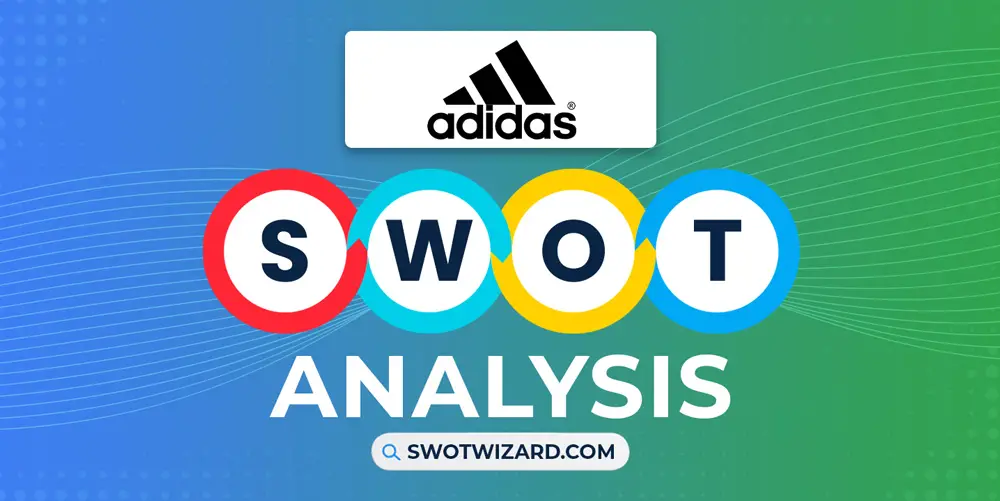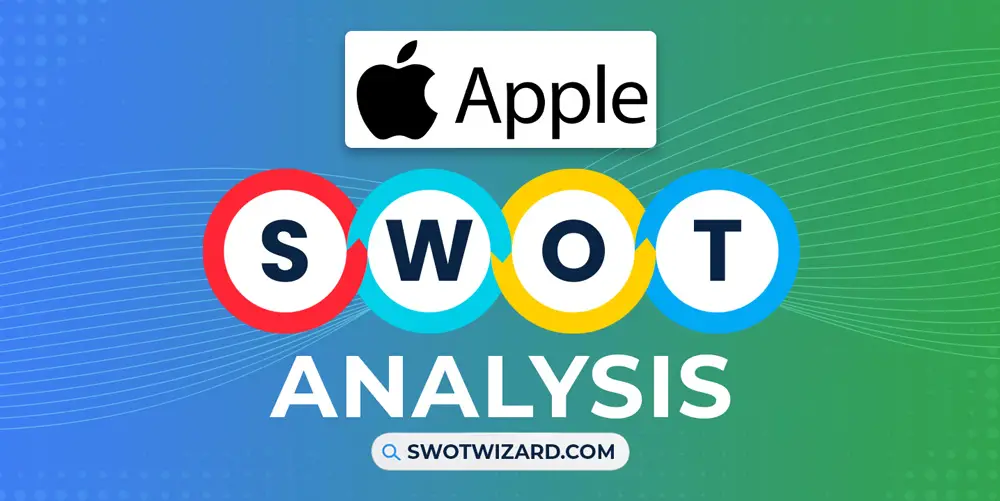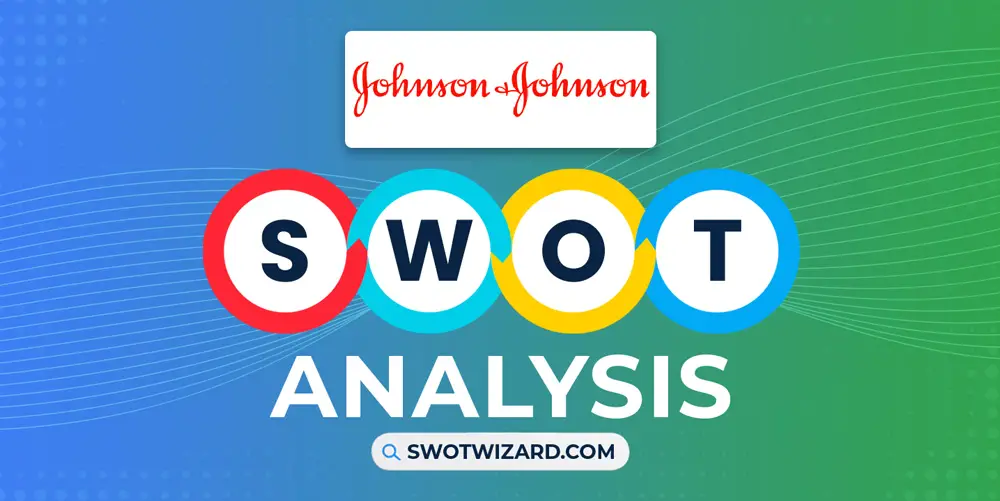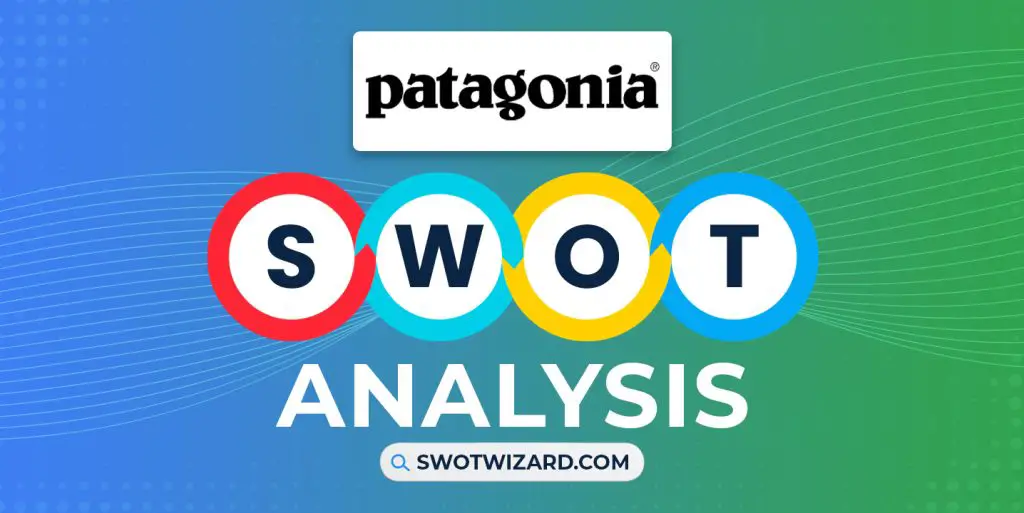No matter which part of the world you’re from, It’s almost a certainty that you’ve seen or worn an Adidas shoe, whether an origin store-bought or counterfeit inspired by many athletes across the globe. As the company grew, its strengths grew, and so did the threats. And, with the internal weakness, it’s trying to overcome, there are many opportunities to grab, which we will get to learn in this Adidas SWOT analysis.
Adidas: Company Overview
| Company | Adidas |
| Industry | Textile, Footwear |
| Founded | July, 1924 |
| Founder | Adolf Dassler |
| CEO | Kasper Rørsted |
| Headquarter | Herzogenaurach, Bavaria, Germany |
| No. of Employees | 59,258+ |
| Annual Revenue | $23.88 billion (FY 2022) |
| Website | adidas.com |
A few years later, after world war II, the company started the shoe brand we all know by its name today, “Adidas,” by a guy named Adolf Dassler. The founder created the famous three-stripes Adidas logo, representing the company’s commitment to innovation, quality, and performance.
The company started with just a few designs and now grew into one of the brands catering to millions of people worldwide with millions of shoes. In 2022, the company reported revenue of € 22,511 million and employed over 62,000 people worldwide, including 7K in Germany.
Adidas has a global reach, with a presence in over 100 countries and partnerships with various athletes and sports organizations.
Product & Services of Adidas
Footwear | Apparel | Bags | Sun Glasses | Fitness Equipment | Balls
Adidas Competitors
Nike | Under Armour | Callaway Golf | ASICS | Puma | New Balance | Fila | Hanesbrands | Foot Locker | Anta
Did You Know?
In Boston, there is a park named “Adidas Park.” You can’t wear any shoe brand besides Adidas inside the park. There is even a tree called the “tree of shame” where other shoe brands are hung.
Strengths – Adidas SWOT Analysis
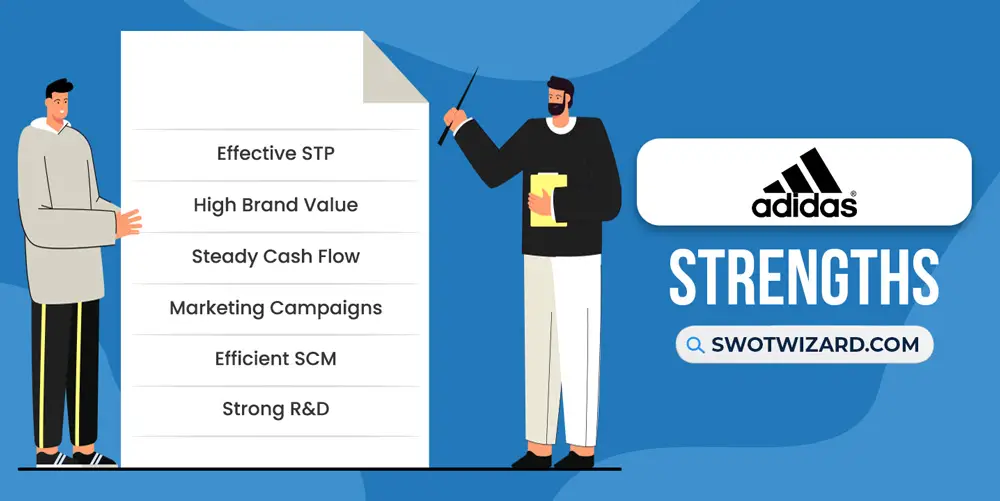
Effective STP: Without a proper STP, no brand can effectively and efficiently run its operations and make decent revenue. Adidas’s perfect segmentation in the market and positioning have made it one of the highest-valued brands and reached more target markets within a short time.
High Brand Value: The brand value itself is one of the most important things that work for Adidas. Besides, brand recognition and reputation are attributed to its innovative product. As per the latest data, the net worth of Adidas stands at $20.19 B, ranking it as the 130th most valuable brand in the world and 5th in the footwear industry.
Steady Cash Flow: With strong finance and stable cash flow, no brand can grow and keep expanding in the market. As for the effort of Adidas, In 2022, the revenue was € 22,511 M, an 6% increase from the last year. If we track back the previous ten years, we can see the growth that pushed and helped the brand keep floating.
Marketing Campaigns: One of the reasons Adidas stayed relevant in the market and constant market share is their marketing campaign efforts. Adidas’ “Impossible is Nothing” campaign garnered 100 million views on social media and drove a 35% increase in online sales. Besides that, hundreds of small and large scales of campaigns are behind the success.
Efficient SCM: The company has optimized its SCM through technology and innovation, such as real-time data analytics, RFID technology, and automation, to increase efficiency, reduce waste, and improve transparency. As a result, Adidas reduced lead times by 50% in the past few years and increased efficiency by 20% by implementing automated order processing in its warehouses.
Strong R&D: The company invests heavily in R&D to develop new materials, technologies, and product designs. In 2021, Adidas reported spending €130 M on research and development, representing approximately 3% of its revenue. As a result, it is paying off by innovating new product lines and increasing brand value.
Weaknesses – Adidas SWOT Analysis
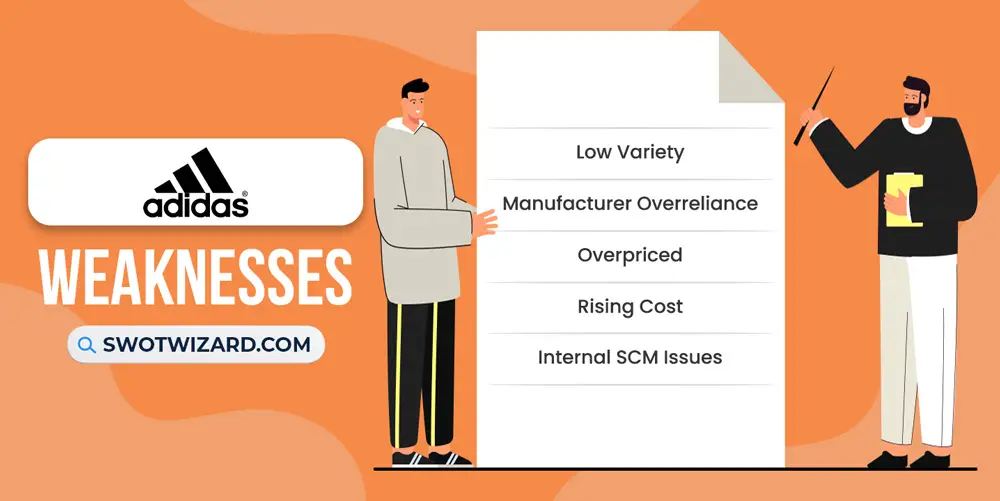
Low Variety: Compared to all the giants in the industry, Adidas doesn’t offer a lot of variety of products in the market. The market leader, Nike, offers footwear, apparel, equipment, and accessories for various sports and lifestyles, but Adidas’s offerings are limited to footwear items.
Manufacturer Overreliance: An overreliance on a few manufacturers can lead to supply chain disruptions and quality control issues. As most manufacturers are from Asia, it can disrupt in many ways, as it did in 2022. Adidas had to face a loss of almost €200 M last year because of Vietnam lockdowns.
Overpriced: Adidas is known for its quality products, but also costs a lot compared to other brands like Nike. Nike offers different price lines for different target markets where people can afford and justify the price. But, in the case of Adidas, their price range starts from a medium, perceived as overpriced in most cases.
Rising Cost: With all the economic downturns, and inflation, the price of everything is rising, and so is the price of raw materials for shoes. In some cases, the price increased by 20% to 50%, and the rising cost has become a massive concern for footwear companies.
Internal SCM Issues: As a core function, the supply chain can make things and processes more accessible but challenging for companies. In Adidas’s case, there have been many issues regarding their suppliers in China, and they are trying to replace them with other alternatives.
Opportunities – Adidas SWOT Analysis
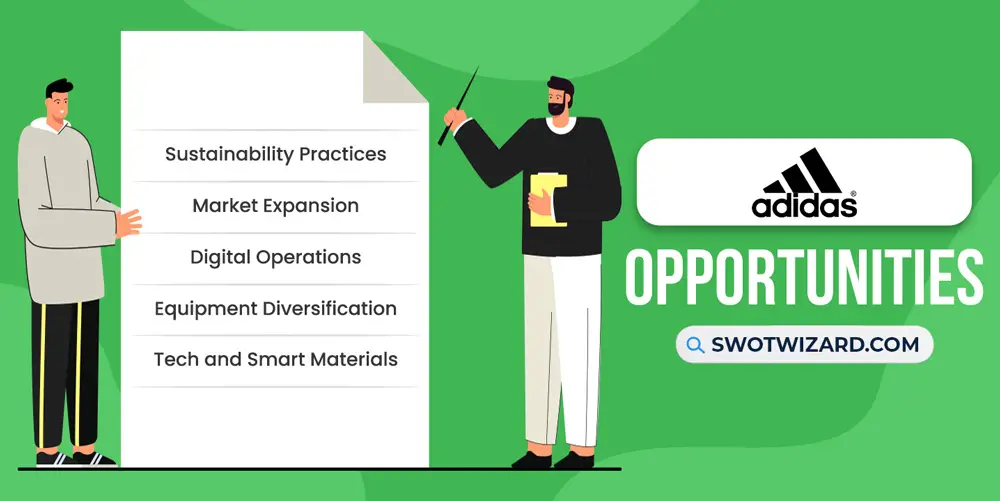
Sustainability Practices: The world is moving toward green innovation and practices. Footwear companies are moving in that direction as more than 300 M shoes become waste yearly in the USA alone. To become part of the movement, Adidas has joined in the sustainability practices, and they should fully utilize it.
Market Expansion: The consumer purchasing power is increasing, and people spend more. With the right product line and pricing, there are enough opportunities to capture the emerging market, as this market sums up more than 4 B people, and the entire market is maturing in these countries, especially the Asian countries.
Digital Operations: In the past decade, the world has undergone massive business digital transformations, thanks to the blessing of globalization. With the uprising of the e-commerce revolution, online sales are growing. Adidas now has a big chunk of revenue from online, almost around 25%, which has been increasing since the pandemic.
Equipment Diversification: By harnessing data, Adidas stays ahead of the competition and offers customers high-performance and stylish gear. But, with innovative products such as Boost cushioning technology and Primeknit fabric, the company can do much more than that by introducing better equipment diversification, such as golf clubs, tennis rackets, etc.
Tech and Smart Materials: In the last twenty years, tech has advanced a lot, and in the footwear industry, the significant tech advancements include 3D printing, sensors, and smart materials for improved comfort, performance, and customization. These practices can help the brand gain value and put them in a unique position in the market.
Threats – Adidas SWOT Analysis
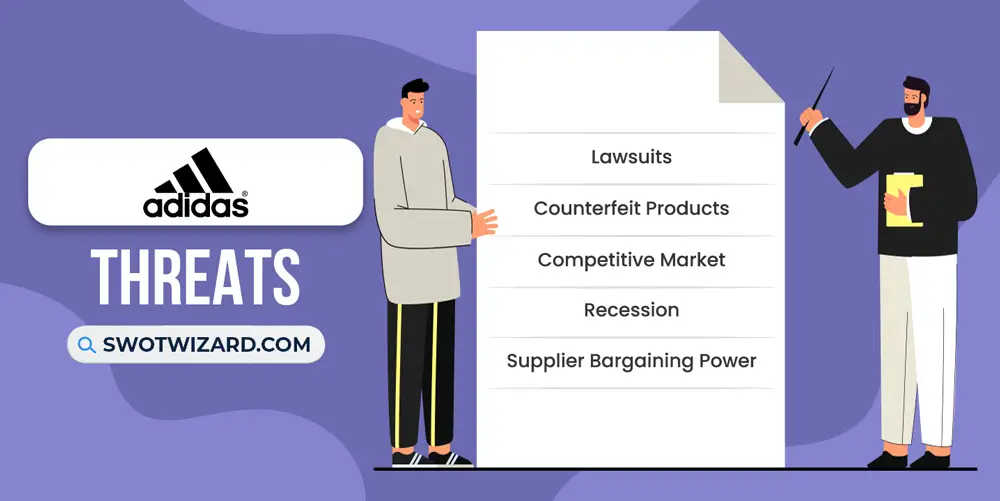
Lawsuits: The more a company grows, the more external factors try to slow it down, and one of the ways to do it is through cases that cost companies millions and precious time. There were legal battles with brands like Nike, and recently, the company even sued Thom Browne for using famous Adidas stripes and even lost.
Counterfeit Products: One of the biggest threats to the shoe industry is counterfeit products, and in 2022, the authority sized $96 M worth of counterfeit shoe items. And as a renowned brand, Adidas’s counterfeit items hold a big chunk of the counterfeit market, and the amount is increasing yearly.
Competitive Market: The shoe or footwear industry is highly competitive with giant companies, such as Nike, Puma, Under Armour, Reebok, New Balance, ASICS, Fila, Converse, etc. And the most threatening thing is that Adidas is losing market share by decreasing and losing its share to the competitors.
Recession: When we are talking about economic downfalls, there are several factors at work, and people spend less and less during these hard times, and even on the necessary items. In the 2008 recession, the footwear companies’ stock fell off a cliff, and as the 2023-24 recession is almost a certainty, it might happen again.
Supplier Bargaining Power: According to data, Adidas’ largest suppliers were China, Vietnam, and Indonesia in 2022. And most of them are Asian countries and hold the biggest chunk of the supply chain. Any disruption or geopolitical influence can significantly affect the company and is a continuous threat.
[Bonus Infographic] SWOT Analysis of Adidas
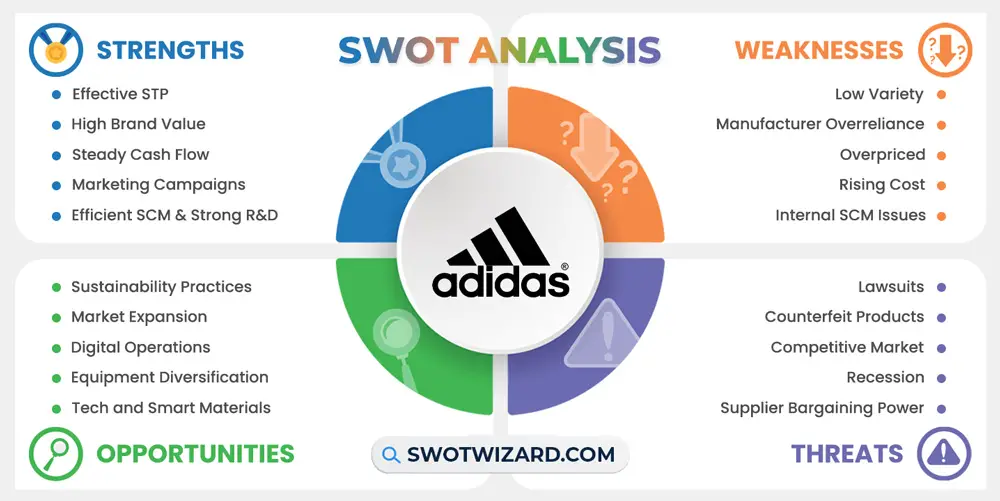
Recommendations for Adidas
As old and experienced as any company can be, some threats will always keep coming, and strengths they need to maintain. Here are some recommendations for the coming days.
- Continuing to invest in R&D to drive innovation and stay ahead of competitors will help reach more markets and expand product lines.
- Focus on sustainability efforts, such as reducing waste and utilizing eco-friendly materials, will position the brand positively in the market and help reduce waste.
- Enhancing e-commerce capabilities and creating a seamless omnichannel shopping experience will help build a loyal customer base.
- Besides, Leverage data analytics to understand customer preferences better and tailor marketing campaigns accordingly.
- Further, expand partnerships with famous athletes and teams to strengthen brand recognition and visibility.
Frequently Asked Questions (FAQs)
What is Adidas Logo Called?
The Adidas logo is called the Trefoil, containing three parallel lines.
Who is Bigger: Adidas, or Nike?
Nike is bigger than Adidas in terms of revenue, as Nike’s revenue in 2022 was $49 B, whereas Adidas’s revenue was $23 B.
Final Words on Adidas SWOT Analysis
As a leading global Adidas brand known for its innovative products, strong marketing campaigns, and commitment to sustainability, its strategic investments in technology and data analytics have helped it optimize its supply chain and offer customers high-quality, personalized products. Adidas is well-positioned for future success with a focus on innovation and sustainability.
References
- Wikipedia contributors. (n.d.). Adidas Wikipedia.
- Adidas results in 2022 reflect geopolitical, macroeconomic, and company-specific challenges. (2023, March 8). Adidas.
- Sangtani, J. (n.d.). A Project Report on A COMPARATIVE MARKET STUDY: NIKE VS ADIDAS. Academia.
- Pratap, A. (2022, April 28). Adidas Research and development expenses. Static.
- Phillips, W. (2022, May 9). Adidas braced for €600m hit from supply disruption. CIPS.
- Felsted, A. (2023, February 10). Adidas Needs the Last Yeezy Shoe to Drop. The Washington Post.
- Cost of merchandise and raw materials is the main concern of the footwear business. (2022, February 3). World Footwear.
- Trivedi, A. (2023, March 4). Trying to Replace China’s Supply Chains? Don’t Bother. The Washington Post.
- adidas Sustainability | End Plastic Waste. (n.d.). Adidas.
- Bhattacharya, A. (2023, January 13). Adidas sued a luxury brand for using stripes and lost. Yahoo News.
- Tracing the Counterfeit Shoe Market. (2022, February 10). ICE.
- Ward-Glenton, H. (2023, February 10). Adidas shares tank after company issues warning over unsold Yeezy stock. CNBC.
- Subhedar, V. (2008, January 15). Footwear stocks fall after recession warning. Reuters.

